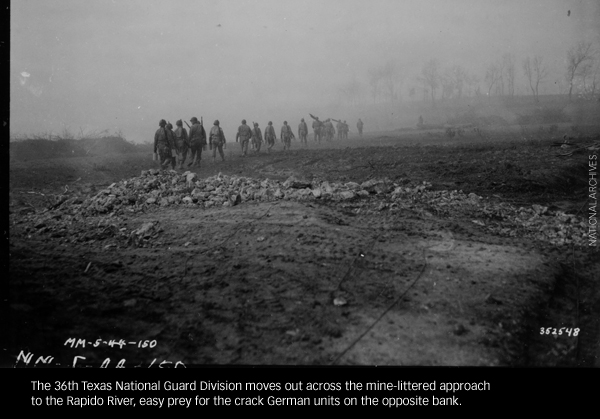
The scene at the Rapido River in Italy in 1944 would be forever seared in the survivors’ memories. “There were bodies everywhere,” said Private First Class Bill Hartung, “mostly parts, arms, legs, some decapitated, bodies with hardly any clothes left on…. And there was always that spine-chilling cry for ‘medic.’ But there weren’t any left.” They had all been blown up by mines or hit by German shells or swept down the raging river and drowned. Hartung’s company had begun the attack—which was to have taken them to and over the river—with more than 200 men. When it was over, only 27 came back.
Sergeant Billy Kirby talked about “boats being hit all around me and guys falling out and swimming. I never knew whether they made it or not. I had never seen so many bodies of our own guys. Just about everybody was hit. I didn’t have a single good friend who wasn’t killed or wounded.”
It was the night of January 20, and the men of the 36th Texas National Guard Division—the T-Patchers they called themselves—were trying to cross the Rapido, in the shadow of Monte Cassino. Over the next 48 hours, in what was intended as a diversionary attack, these men would be ordered to do the impossible, leading to one of the greatest tragedies the U.S. Army suffered in World War II. Of the 4,000 T-Patchers who made the attack, less than half returned. The rest were killed, captured, wounded, or missing in action. The Germans lost 64 men, with another 179 wounded.
Long after the battle was lost, and even long after the war was over, the disaster at the Rapido continued to provoke anger and accusations. Diversionary attacks can often, by their very nature, be disproportionately deadly to those who carry them out. But with General Mark Clark in charge of the operation, a man whose career was dogged by controversy, questions persist: Was his order to attack worth the risk of so many lives? What alternative, if any, did he have to sending those men to be slaughtered as they tried to cross the Rapido?
The story of the Rapido began on Christmas Eve, 1943, in a villa near Tunis. Winston Churchill was there, along with members of the British high command and a very skeptical General Dwight Eisenhower. The war in Italy—Churchill’s war, to which the Americans had agreed only grudgingly—was at a stalemate. American and British troops were bogged down in the cold, mud, rain, and snow, with nightmarish casualty counts as they fought their way from one mountain ridge to the next. The American high command, now focused on the invasion of France only six months away, wanted to halt any further advances in Italy and dig in where they were.
Churchill argued that continuing the offensive would force the Germans to keep troops occupied there so they would not be diverted to France to oppose the Allies in Operation Overlord. To break the stalemate along the Germans’ heavily fortified Gustav Line, which ran in part along the Rapido River and Monte Cassino 80 miles southeast of Rome, Churchill suggested out?anking the Germans by landing troops at Anzio, 60 miles northwest of the line. That action—so Churchill argued—would compel the German army to divert troops away from the Gustav Line, allowing the Allies to cross the Rapido, link up with the landing force at Anzio, and quickly move on to capture Rome. He insisted that it would all be over in a matter of days.
Churchill got his way yet again and Eisenhower, forced to agree, was not pleased. “I think you’re making a mistake,” he told Churchill. Undeterred, Churchill moved swiftly ahead, selecting Lieutenant General Mark W. Clark to command the invasion.
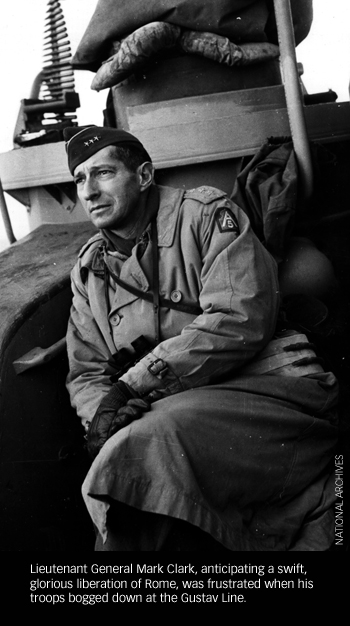 A 1917 graduate of West Point, Clark was a captain a year later when he led his battalion to the front line in France. It was his first time in combat. Just as he reached the trenches, a German shell exploded, wounding him in the arm and shoulder. Although Clark soon recovered, he spent the rest of the war as a supply officer. Through a series of lucky breaks, though, combined with a talent for organization and high grades in the army’s leadership schools, Clark’s career took off. In 1941, he was made a brigadier general and assistant chief of staff at the War Department, promoted over many others who were senior in age and rank. “I just made a hell of a lot of people mad,” he said.
A 1917 graduate of West Point, Clark was a captain a year later when he led his battalion to the front line in France. It was his first time in combat. Just as he reached the trenches, a German shell exploded, wounding him in the arm and shoulder. Although Clark soon recovered, he spent the rest of the war as a supply officer. Through a series of lucky breaks, though, combined with a talent for organization and high grades in the army’s leadership schools, Clark’s career took off. In 1941, he was made a brigadier general and assistant chief of staff at the War Department, promoted over many others who were senior in age and rank. “I just made a hell of a lot of people mad,” he said.
By 1943 he was a lieutenant general, fueling even more resentment, along with a rising chorus of charges that he was arrogant, ambitious, ruthless, and vain. “Too damn slick,” George Patton said of Clark, “more preoccupied with bettering his own future than winning the war.”
Clark had one major goal during the Italian campaign: to be the man who conquered Rome. He told New York Times reporter Cy Sulzberger that he wanted Sulzberger to ride in his jeep when they made the breakthrough, so the reporter could “tell the world just how Mark Clark took Rome.”
In January 1944, however, Clark was a long way from his prize, stopped cold at the Gustav Line, which ran across the entire Italian peninsula. Churchill’s plan to make an end run around the Germans and come ashore at Anzio offered new promise, a fresh opportunity to reach Rome.
Clark’s only experience with an amphibious operation had been four months earlier at Salerno in Operation Avalanche, and it had been a near disaster. He had gone ashore using the T-Patchers and a British division, but his poor planning enabled the Germans to come close to pushing both forces back into the sea. They held on though, and now his challenge was to carry out two new amphibious assaults—the landing at Anzio and the crossing of the Rapido River.
Clark now shifted the plan slightly from Churchill’s proposal, and decided the Rapido crossing would be the diversion, hopefully fooling the Germans into thinking that a major attack was underway there. He expected the Germans to then shift their troops southeast from the area around Anzio
The plan to cross the Rapido seemed simple, but no one other than Clark’s own staff believed it had any chance of success. “I swear, I do not see how we, or any other division, can possibly succeed in crossing the Rapido River,” said Major General Fred Walker, the beloved 56-year-old commanding officer of the 36th.
Clark was so certain of victory that he ordered Major General Ernest Harmon to have the tanks of his 1st Armored Division ready to cross the river and head for Rome as soon as the engineers had placed the bridges across the Rapido. “Impossible,” Harmon responded.
General Walker tried to point out to Clark and his recently appointed corps commander, 55-year-old Major General Geoffrey Keyes, that the section of the river Clark had chosen as a crossing point—an area three miles south of Monte Cassino—was the worst possible place to make such an attempt. Walker suggested a position north of Monte Cassino where German defenses were weaker and the river was fordable, thus eliminating the need for boats and bridges. “Clark and Keyes were not interested,” Walker wrote some time later. “They do not understand the problems and do not know what I am talking about.”
Walker knew all about the folly of trying to cross a river under heavy enemy fire. On July 15, 1918, he had been a battalion commander at the Second Battle of the Marne when a force of 10,000 Germans tried to cross the Marne River under fire. Walker’s out?t of 1,200 men slaughtered them. It was a lesson he never forgot. “There I learned the great advantage that defenders of an unfordable river have over the attackers,” he wrote. And now, 25 years later, history was about to repeat itself. Only this time, Walker’s men would be the ones to make the attack, and what they faced was even more forbidding than what the Germans confronted at the Marne.
The Rapido had been dammed by the Germans, turning the river banks into mud-filled swamps that prevented vehicles of any kind from approaching. Every boat and bridge component would have to be hand carried to the river banks while the troops were under fire. The Germans had felled the trees and chopped down the shrubs for more than a mile inland, leaving the attacking troops no cover. Hundreds of mines had been spread over the muddy approaches, every square foot of which was zeroed in on by German machine guns and artillery, including lethal Nebelwerfer rocket launchers.
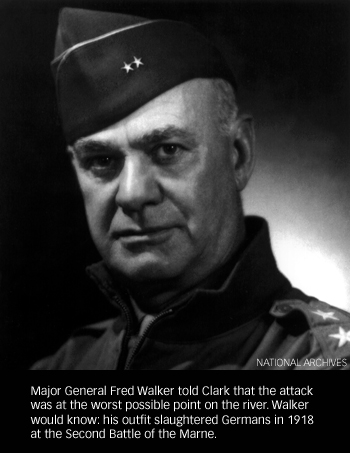 The river, 50 feet wide and 9 to 12 feet deep in places, was a torrent of icy water moving to the sea at a current of some 8 miles per hour, deadly swift to men weighed down with heavy clothing and equipment forced to paddle across in rubber boats under enemy fire. If they did reach the opposite side, they would have to scale steep banks and face a line of dugouts, trenches, concrete and steel bunkers, and machine gun nests clustered behind double rows of barbed wire.
The river, 50 feet wide and 9 to 12 feet deep in places, was a torrent of icy water moving to the sea at a current of some 8 miles per hour, deadly swift to men weighed down with heavy clothing and equipment forced to paddle across in rubber boats under enemy fire. If they did reach the opposite side, they would have to scale steep banks and face a line of dugouts, trenches, concrete and steel bunkers, and machine gun nests clustered behind double rows of barbed wire.
The soldiers of the 36th Division had been in almost continuous combat for four months. They were worn out. Rifle companies had lost up to 60 percent of their men, along with nearly three of every four junior of?cers. New second lieutenants, fresh out of Officer Candidate School, were sent up to the 36th by the truckload, some arriving just hours before the assault. Five hundred green replacements joined the T-Patchers shortly before the attack. Many of them did not have time to find their assigned units. In the end, they fought alongside strangers who did not even know their names. “We had so many replacements,” Sergeant Bill Allen said, “I didn’t have a man in my platoon I had known for more than a few days, much less a few weeks.”
No wonder men of all ranks believed the operation was doomed. “We had the feeling we were being sacrificed,” one sergeant said, “a feeling that we couldn’t win.”
“We are undertaking the impossible,” General Walker wrote in his diary at the time. “There is nothing in our favor.” Even General Keyes, the new corps commander, was beginning to question whether the attack could succeed. Both he and Walker expressed their doubts in letters to Clark, along with suggestions about how to better the odds. Clark never replied, but he wrote the following in his diary: “It is essential that I make the attack, fully expecting heavy loss. The attack is on.”
The attack began at 7:30 p.m. on the 20th with an artillery barrage of more than a thousand shells fired every six seconds, designed to explode in a pattern every six square yards. Monks in the abbey atop Monte Cassino described the assault as a “hellish firing” that shook the whole monastery. For all the noise and fury, however, there were few German casualties. As the T-Patchers began to move toward the river, the enemy’s defenses remained intact.
A few minutes after the American shelling began, the Germans fired back, catching the T-Patchers out in the open, mired in the muddy approaches to the river. The troops ran for cover, leaving the specially marked lanes that had been cleared of mines, but there was no place to hide. “You couldn’t tell what the hell was going on,” one survivor said. It was a bloody disaster—and it was only beginning. The men were not even close to the crossing point and they were already disorganized. The wounded were screaming for the medics. Most of the rubber boats had been torn to pieces by shrapnel.
Lieutenant Carl Strom went ahead of his men to find their launching site and when he glanced back he saw two explosions wipe out his entire platoon. Not a man was left standing. Other soldiers who reached the river bank found their inflatable boats had been damaged by shrapnel and were unusable. Some boats were caught by the current and swept downstream. No one knows how many men drowned or were killed by German shells, mortars, or machine gun fire as they struggled to get across.
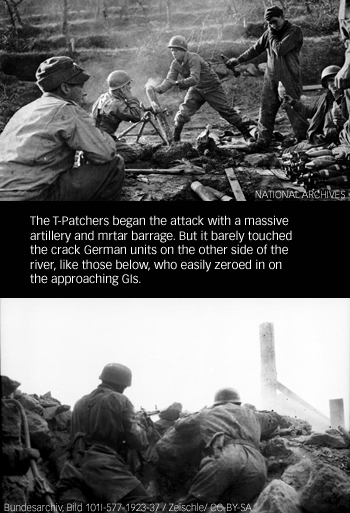 Lieutenant J. E. Phillips watched his men climb into the assault boats. “The boats would partially swamp when they slid into the water, then about ten men would get in with all their equipment on and shove into the stream. The minute the current hit the boat broadside it carried it downstream. I could hear the paddles slapping water and hitting together and the men yelling when their boat turned over. It curdled your blood to hear those men drown.”
Lieutenant J. E. Phillips watched his men climb into the assault boats. “The boats would partially swamp when they slid into the water, then about ten men would get in with all their equipment on and shove into the stream. The minute the current hit the boat broadside it carried it downstream. I could hear the paddles slapping water and hitting together and the men yelling when their boat turned over. It curdled your blood to hear those men drown.”
By 9 that night, only a few hundred men had reached the far side of the river. They dug in, using their hands and helmets, scraping shallow holes in the marshy soil. It was not until 4 a.m. that the engineers assembled the lone bridge that would survive the shelling. As troops raced across, many were shot and toppled into the freezing river. Given the fast current, no one could save them.
Although the assault continued through the night, the majority of the men never got as far as the river, much less across it. By dawn, it was obvious that it would be impossible to assemble the heavy bridge needed for the tanks to cross. The attack was a failure. “At a cost of hundreds of casualties,” Walker wrote, “a handful of men were on the far bank of the Rapido. They were fighting for survival and it was only a matter of time until they would be wiped out.”
Nonetheless, at 10 the next morning, January 21, General Keyes ordered Walker to attack again immediately, to get more men across the Rapido, and to build the bridges for the tanks. The landings at Anzio were less than 24 hours away and Keyes said General Clark believed that renewing the attack across the Rapido to hold the attention of the German army was critical. But Clark, even though he suggested that heavy losses were inevitable, was apparently sanguine about the Rapido attack’s chances: he told Keyes to tell Walker he wanted the tanks to be able to move out toward Rome within a few hours.
Walker was incredulous. He told Keyes it was impossible to cross the river in daylight when they had not been able to cross under cover of darkness, but Keyes was unmoved. He had his orders from Clark and no excuses would be tolerated.
The second assault on the Rapido began at 4 that afternoon. Soldiers laid down a heavy smokescreen as cover, plunging everything into darkness. “Off they went,” one officer said, “trudging like men sent to the scaffold.” Another remembered walking down a trail toward the river when suddenly “it didn’t seem what we were walking on was dirt and rocks. We soon found out that it was dead GIs, stacked sometimes six feet high. They were from the crossing the night before.”
The second attack fared no better than the ?rst. Boats sank, bodies were swept away. Men were felled by mines, mortars, and shells, or cut in half by machine gun fire. By 2 a.m., only a couple of precariously swaying footbridges, hastily improvised, had been erected, but it was as deadly to try to cross them as it was to paddle across in the rubber boats.
The T-Patchers who made it to the far side found themselves trapped under constant fire, unable to advance. They could not make radio contact, secure help for the wounded, or replenish their dwindling stock of ammunition. By dawn the next day, their situation was desperate. They had advanced no more than 600 yards at the farthest point and there they were stuck in shell craters and foxholes. The bridges had been destroyed so there was no easy way back. By noon the battle was all but over and the Germans began rounding up those still alive.
Private First Class Rudolph Trevino looked up to see a German soldier holding a bayonet against his throat. “I hope he pulls the trigger,” Trevino said to himself, “and it will be all over.” But the German did not shoot and Trevino was marched off—to spend the next two years as a POW.
In the early afternoon of the 22nd, Keyes ordered Walker to prepare for yet another attack, to be launched the following day. This would be the third attempt. Keyes thought the new assault would be much easier than the ?rst two because he falsely believed the 36th had already established a perimeter on the far side. Also, he told Walker, the Germans must be seriously weakened from the previous two nights of fighting. Walker said he did not have enough boats or bridge equipment for another crossing, that his men had not established a perimeter on the other side, and that he detected no sign that the German force had been weakened. It was no use arguing; the attack had to go on.
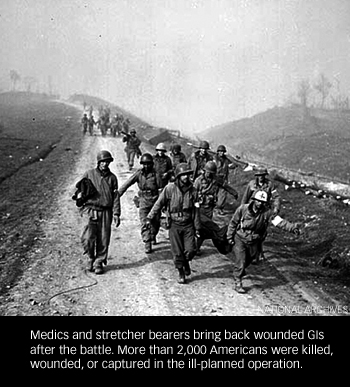 Fortunately for the T-Patchers, Keyes telephoned Walker later that afternoon to cancel the attack, on orders from General Clark. The Anzio landings had met little opposition and Clark was pleased; he had surprised the Germans. Finally, the road to Rome was open, so he no longer needed General Harmon’s tanks or the diversion of a Rapido crossing. Neither Clark nor anyone else could know that Allied troops would be stalemated for four months at the small Anzio beachhead.
Fortunately for the T-Patchers, Keyes telephoned Walker later that afternoon to cancel the attack, on orders from General Clark. The Anzio landings had met little opposition and Clark was pleased; he had surprised the Germans. Finally, the road to Rome was open, so he no longer needed General Harmon’s tanks or the diversion of a Rapido crossing. Neither Clark nor anyone else could know that Allied troops would be stalemated for four months at the small Anzio beachhead.
The doomed attacks across the Rapido had been for nothing, leaving behind 1,330 men killed or wounded and 770 captured. It was time for the blame and recriminations to begin.
The man who ordered the ill-fated attack soon made clear his choice of scapegoat. On January 28, General Clark told Walker that most of Walker’s senior of?cers were being relieved of their duties. Two junior officers—Walker’s sons—were also relieved. Worse, Clark appointed the replacement of?cers himself, giving Walker no say. Walker was not even allowed to select his own chief of staff.
Walker expressed his anger to Keyes. He felt that Clark and Keyes were trying to shift the blame for the failure to him. “I didn’t hold back,” Walker wrote in his diary. “I let him know what had been gnawing at me ever since Clark relieved my officers. I am fed up with the whole damn mess.” Walker was convinced that he was about to lose his job for a decision he had no hand in, for following orders he had no choice but to obey.
Keyes assured him that he would not be relieved until he restored the 36th Division to fighting shape and led them to a victory in combat. Then it would be politically prudent that he be reassigned, Keyes said, “without any feelings on the part of your superiors that you have not been successful.” So Walker’s fate had been determined, but first he needed a military success to protect his reputation, and more importantly, the reputation of General Clark, who had ordered the attack in the first place.
Walker secured his victory two months later, leading his T-Patchers in a brilliant and daring maneuver at Velletri to outflank the last German defensive positions in advance of Rome, thus opening the way for Clark’s triumphant capture of the city. Clark’s name made headlines and his photograph graced the front page of virtually every American newspaper. But his moment of glory on June 4, 1944, was fleeting. Two days later, the Allies landed on the beaches at Normandy. The capture of Rome was old news.
A week later, Walker received a letter from Clark. Walker had led the 36th to success, ensuring Clark would become a hero, and now it was time to go. The careful wording of the letter informed Walker that he was not being relieved of command; rather, he was being given the opportunity to take over the army’s infantry school at Fort Benning, Georgia—that is, if he wanted the assignment.
“I have been expecting this letter for some time,” Walker wrote in his diary that night. “It is cleverly worded to save Clark’s and my faces and to give the impression of a choice, but there is no choice.” General Walker would spend the rest of the war at Fort Benning; he retired in 1946, having received no further promotions.
Mark Clark became supreme commander of Allied forces in Italy, won his fourth star, and was appointed high commissioner for Austria at the end of the war. But the memory of the Rapido operation cast a long shadow over his career, perhaps blocking any chance he may have had of becoming army chief of staff. He did hold several high positions, however, including commander of the United Nations forces during the Korean War. He retired in 1954 and served 22 years as president of The Citadel, a military college in Charleston, South Carolina.
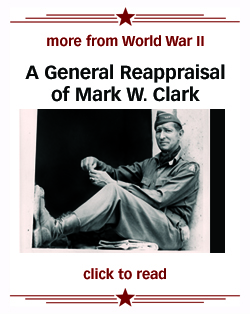 Historians still debate whether the attack at the Rapido was a blunder or whether Clark’s decisions were dictated by circumstances over which he had no control. Was he making the best of a bad situation? Did he have any alternative? He had only two divisions for the Anzio landings when he believed he needed a minimum of three. Clark also had a shortage of landing craft for the operation; if too many were destroyed in the first waves, it would be difficult if not impossible to bring ashore more troops and supplies. And if the Germans reacted quickly enough, they could repel the landing force, wiping out both divisions.
Historians still debate whether the attack at the Rapido was a blunder or whether Clark’s decisions were dictated by circumstances over which he had no control. Was he making the best of a bad situation? Did he have any alternative? He had only two divisions for the Anzio landings when he believed he needed a minimum of three. Clark also had a shortage of landing craft for the operation; if too many were destroyed in the first waves, it would be difficult if not impossible to bring ashore more troops and supplies. And if the Germans reacted quickly enough, they could repel the landing force, wiping out both divisions.
So the idea of a diversion, of deceiving the Germans into thinking that a major advance was under way at the Rapido, just might persuade them to shift troops south from the area around Rome and Anzio. It could have worked. At the risk of heavy losses to one division—the 36th—it might have bettered the odds of saving his two divisions coming ashore at Anzio. Committing the T-Patchers to cross the Rapido turned out to be unnecessary after all, but should Clark have been expected to know that in advance?
In 1946, Clark was subjected to a congressional hearing instigated by irate survivors of the 36th Division. Their formal resolution charged him with responsibility for “one of the colossal blunders of World War II” by ordering the attack across the Rapido. The hearing was widely covered in the press and generated a great deal of negative publicity for Clark. Nevertheless, Secretary of War Robert Patterson publicly exonerated Clark of all blame, concluding that the crossing of the Rapido River “was a necessary one and that General Clark exercised sound judgment in planning and in ordering it.”
In the end, the question of whether it was a well-planned and necessary assault or a blatant failure of leadership would not change the outcome for those who were there. The survivors of the 36th Division never forgot it and many never got over it. Bill Hartung summed it up, recalling how he felt after finally returning to the Allied side of the river: “I had turned into an old man overnight. I know I was never the same person again.”
Duane Schultz is a psychologist and the author of several works of military history, including Into the Fire: Ploesti, the Most Fateful Mission of World War II and The Most Glorious Fourth: Vicksburg and Gettysburg, July 4th, 1863. His most recent book is Crossing the Rapido: A Tragedy of World War II (2010, Westholme Publishing).




